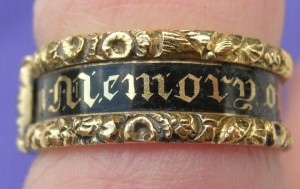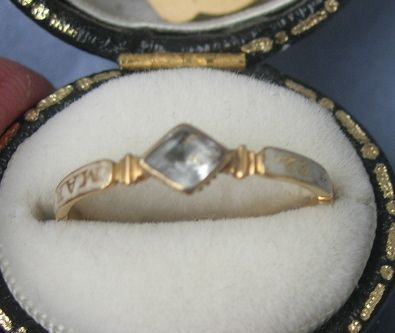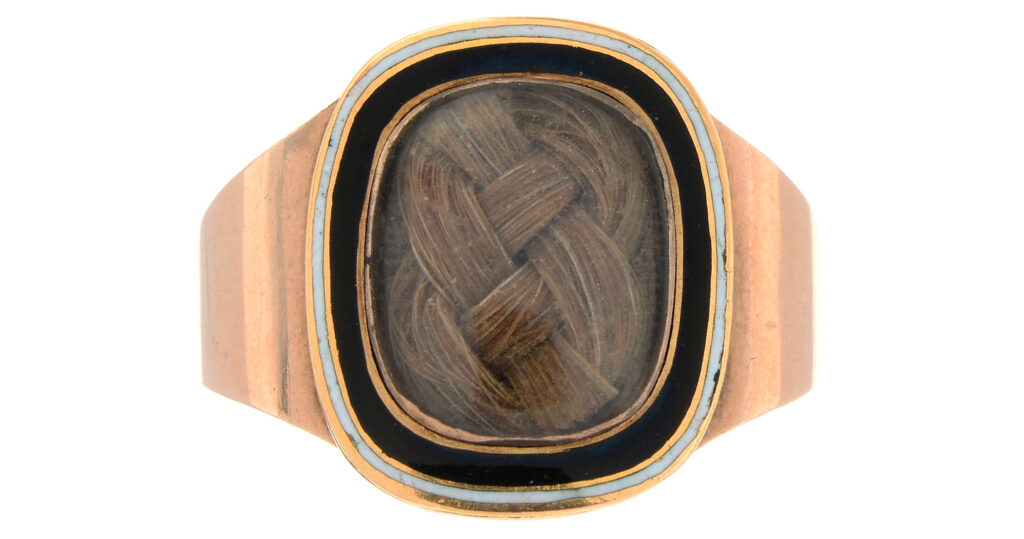Triple Mourning Ring, White Enamel, 1791
The profound statement of a mourning jewel brings a tremendous amount of gravity to its existence. The dedication in a jewel speaks from a personal level, where a person in deep grief needs to show their anguish as a statement within their very fashion and also speaks about a culture where the mortality rate was high.
This ring has the names of Harriot, Robert and Eliza Wilsher, with a hallmark referencing 1791. Their lives are encapsulated upon white enamel in the band; a statement with only the most sparse use of symbolism. Within its elements, this ring does not use any affectation or pomp to create its meaning, it simply is a grand memorial to the lost lives of loved ones within a family.
For the modern collector and historian, this ring isolates very important elements from its time and construction that will assist in identification of contemporary pieces. From its date of creation, to the use of the band as a memorial and white enamel, there are enough elements to create a narrative of the late 18th century in jewels and lifestyle.
The 1790s
Neoclassical style had reached its height by the 1790s. This was a style built upon the ideas of the Age of Enlightenment and a view towards classical (Greek/Roman) culture as an influence into contemporary art, fashion and thought. Much of this impetus came from archaeology, driven by such writings as that of Johann Joachim Winkelmann, through the definition of variance in ancient art with its narrative connection to contemporary times. Known as ‘revival’, ‘reformed’ and ‘the true style’, Neoclassicism wasn’t referenced as much until the 19th century, but was a clear break from the Rococo style that had previously dominated society. Rococo had followed on from the Baroque period, with its influence on ecclesiastical domination through art and architecture.
Neoclassicism led to a greater connection towards the ‘self’ in art and though; its influence in making the centre of mourning being the person and its representation through the jewel cannot be understated. While many Neoclassical jewels had the allegorical depictions of symbolism to denote love and death, the true nature of this was a reaction to what had come before. Pre-1765, the focus upon Memento Mori styles had led to death being the symbolic representation of the body in decay. Skulls, bones and the symbols of judgement and time (hourglass – tempus fugit), death (a skeletal figure with the scythe ) all led to death as an inevitable fundamental that would define the nature of the human existence.
With that stated, let’s look towards this ring in the 1790s.
Here, we see the use of white enamel, bold, upper-case fonts and a wreath/leaf motif that puts the family members in a possible hierarchy. If we are to assume that the children were born during childbirth, then the name of Harriot would denote the mother, however, the three in white enamel may be due to the connection of the family as children. These children may have died during birth or through a other methods at once. What we can identify is that the ring was bespoke and created for the death of the three.
In fashion, the late 18th century was a time that was leading towards mourning standardisation, something that would be solidified by the death of Princess Charlotte in 1817:
“‘…dress was cut with a train and turned back with a braid attached to the side of the skirt, which was pulled through the pockets.’ This is where the overskirt is turned to the back and lifted up, revealing the petticoat underneath, called; robe retrousee dans les poche, the centre front robings were joined with hooks or ribbons. Cuffs were cut with one fold and deep hems, the waist was held in place by a crape belt that was tied on. This left two ends hanging down to the hem of the skirt. A woman’s accessories were a crape shawl, gloves, shoes with metallic bronzed buckles, a black woollen muff and a black crape fan. Head dresses of black crape and white batiste were referenced. For much of the century, however, ‘paniers’ were fashionable, but in the French style, with loose pleating falling from the shoulders to the back. The English manner of this was with the back pleats stitched down as far as the waistline. Also popular were lace ruffles at the neck and the cuff, embroidered stomachers, silver gilt lace, appliqué work and small aprons. None of these were permitted for mourning wear. Mourning wear for women still remained consistent in that it remained plain, black or sometimes white fabric”
Evolution of the Band
The band is one of the most popular mourning ring styles used to memorialise a loved one. This is due to its width and ability to accommodate changing styles; always being able to present the name or dedication around its outer rim within the context of fashion. The band itself is an ancient creation, being a simple design that could be worn on the finger and inscribed in any way to denote sentimentality. For the purposes of modern history, the band in use for the mourning industry of the 17th-19th centuries had its roots in the posie rings created in the 15th and 16th centuries. These rings, with their internal inscriptions, made standardised statements of love from contemporary chapbooks that empowered social change through the interpersonal relationship standard of living for another, rather than being under the dominance of a deity. Chapbooks, pamphlets containing popular literature, were a popular source for many of the sentiments written inside the posie rings. These cheap pamphlets grew in popularity, as they were sold cheaply (commonly a penny or halfpenny) and contained many popular ballads from the time. This pre-dates mass produced media of the early 19th century, when steam presses led to the rise of cheap newspapers. From the mid 16th century, these cheap and crudely produced booklets contained relevant popular content that varied from entertainment to political and religious content. Here, the relation of the ring to the popular literature is the key factor in understanding just how the posie’s relation to society. They were jewels that could be for the commoner, but also transient as a style of love token through society because of their simple statements. This is a fundamental change in society, as people now had a voice and a platform to present their opinions, with their lifestyles now being in flux and more mobile, they could present their feelings, love, death and culture in a jewel on their very finger.
The distribution of rings had been written into wills of the late 16th and early 17th Centuries. Most famously, William Shakespeare in 1616 declared that in his will that his daughter and wife should have rings stating “Love My Memory”.
More can be read about this at
As the band had entered society as an acceptable jewel of sentimentality, the usage for mourning was a natural evolution of the style. The significant cultural change which had bought about the sentiment of love being seen by others in a jewel had presented mourning and grief as an item of personal representation in the 18th century. The 18th century England had seen the destabilisation of the government through the death of Charles I, the rule of Cromwell and the subsequent reformation of the Crown under Charles II, combined with a small ice age and the fires of London in 1666. High mortality, combined with a questioning of the social elements of protection had led a populace from the ecclesiastical value systems into the new Enlightened values which could promote social movement and the ability to accumulate wealth.
The band in jewels represents this. As it is a platform of personal representation, grief and love that are shown to friends, family and the public on the person, it adapts to popular fashion and is shown as a statement. Look to the following rings:
From the early 18th century, there is a clear movement towards utilising the band as a prominent area for sentimentality. Prior to this, the shoulders were used for elaboration in design, leading towards a bezel set with crystal. Under this would be hairwork with a sentimental/mourning dedication.
By 1720-1770, the Rococo period had taken over, with elaborate flourishes to the band, emulating the ribbon motif.
At the turn of the 19th century, the geometric, sharper lines had taken over in popularity. This influence, which was more based around shape, led to the Gothic Revival period.
The band had adapted to the Gothic Revival period by the 1820s, utilising the Gothic lettering around the band and having customised embellishments were applicable.
By the 20th century, mourning jewellery was in decline, but still produced from catalogues or for people who held to the earlier generation’s concept of memorialisation. This ring is considered quite late for its time, but still holds onto the basic elements from the 18th century.
From this, we can see how the band evolved with similar messages. These messages were intrinsic to the wearer and still resonate today, however, they also represent a fashionable status with their refinement of the Neoclassical elements into the Gothic Revival and Victorian ages into the 20th century.
White Enamel
White enamel is the second most popular mourning material used, next to black enamel. Black enamel, being a colour that has represented death through to pre-history, was (and still is), the colour that was inlaid in jewels, most commonly with the ‘IN MEMORY OF’ sentiment. This was highly standardised by the 19th century, but in the 18th, there was much more flexibility with the use of sentiment and enamel colour.
What was common was the white enamel. Death, for its reasons of desecration and entrance into entropy, lead towards black, which in itself, is the absence of light. White, when in use, is the connection to purity, innocence and virginity, show the untarnished representation in colour towards a person’s morals and values. A young person who was not married was seen as unblemished in social status and the use of the white enamel to show this virtue is why white enamel is used in this context.
This ring shows nothing more than the sentiment of the person in the value of the name, which is extraordinary, when connected to jewels that show the name with a sentiment on the interior or exterior. White enamel, being more of a bespoke material, is something which can be seen as a personalised element in rings and bands. This ring shows that the style was indoctrinated through the following bands:
By the 1730s, we see the elements of white enamel and the band together. The use of the name and the date denote the death of the unmarried, and hence “pure” person was memorialised through the basic band in the white decoration.
In 1740, the combination of Memento Mori and the Rococo style had created a fashion of opulent design and factual death. Under crystal, the skull and death motifs were common, while the decorated ‘ribbon’ band was typical of the Rococo style.
When the Neoclassical movement was in its height, the allegorical depictions still retained the style of the previous bands. White enamel decorated rings with the name of the subject who had passed on, with the bezel now showing the typical sentimental images of the urn, weeping woman and willow.
Past the Neoclassical period, the streamlined geometric styles that were popular in the Regency era had shown a cleaner design to the band, with the focus on font and a singular element being the most prominent element to the jewel itself.
With the names being the most important elements, this 1791 ring was created for the singular purpose of memorialising the children. At no stage was this designed around the motif or affectation; it was made for the purpose of memoralising a family.
Family Memorials
Housing several members of a family within a jewel isn’t a unique element of this ring, but it is a rare one. Several family dedication often refer to sentimental jewels, as the mortality rate was high for the 18th and 19th centuries, but death at once for children was an occurrence, rather than a factor. Family in a jewel can be seen in the following pieces;
Within this bracelet, we see the influence of several strands of hair woven into its structure and sentimental area. Upon the reverse, the initials of several people are shown, revealing a bracelet that is created for the purpose of creating a token of love for a family.
This combination of people into one jewel is not uncommon, but it is a factor which identifies them above others, as most jewels are focused upon a singular subject.
Within this brooch, we see the mother and daughter woven together, as the brooch was made as a gift. Hair was a popular material of giving the self to another, particularly during the 19th century, yet it has its roots dating to pre-history. What these pieces do show is that the 1791 ring was not uncommon in its sentiment, but more within its creation.
Weaving two elements of hair together in a sentimental or mourning jewel show that the wearer and the subject were connected. Where names are connected in hairwork and the piece doesn’t denote death, then that is the merging of two people through love to be worn as a love token.
Greater family memorials lead towards folk art, which can be seen in mourning samplers. These samplers were often made in the house and their manufacturing technique learned through the family itself. Mother to daughter teaching of the stitch-working needed for the sampler led to the sentiment being a very personal one. This was due to not being involved with third-party manufactures for the creation of the sentiment, what could be said could be woven and that would be presented in the house. Often combining the personal sentiments, the signature of the weaver, or the personal message of the weaver, would be in its text and presented in the household post-mortem.
This ring goes beyond the standard of the time, showing the three people within the one band. How this had been possible within its context reflects back upon the family values. A family which had the wealth to create such a ring, considering that rings could be bought at low cost from a standardised style and customised, created this ring from a style that was standardised, but was created entirely bespoke. A mourning ring with three levels of dedication are incredibly rare and relegated only towards those who had the wealth to purchase/create them.





















